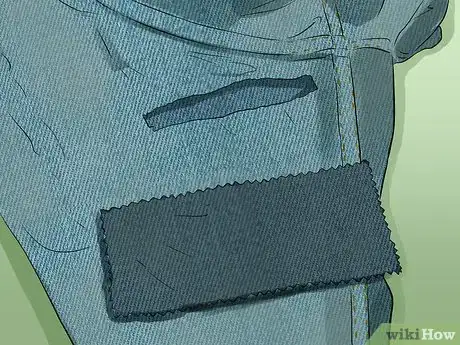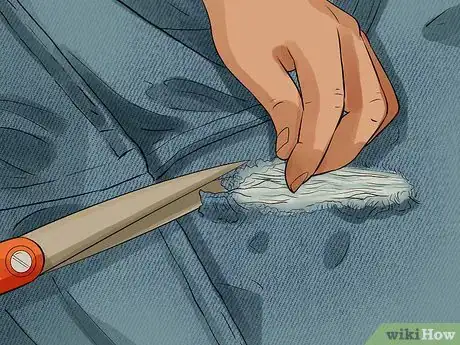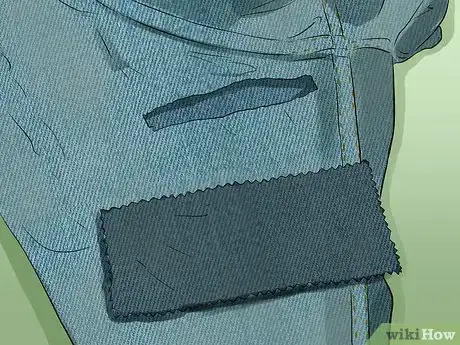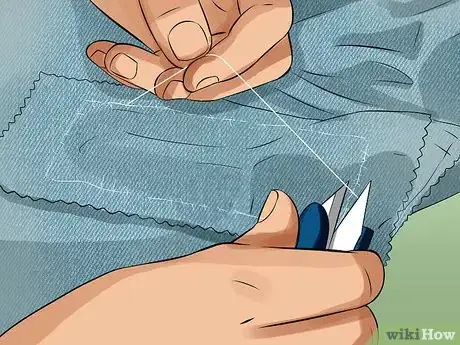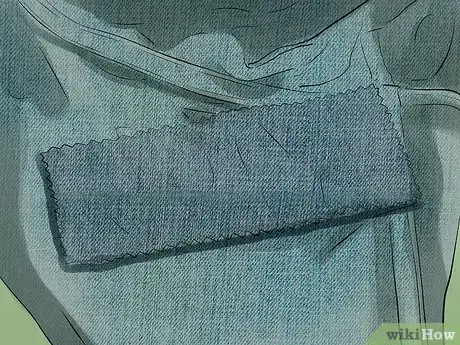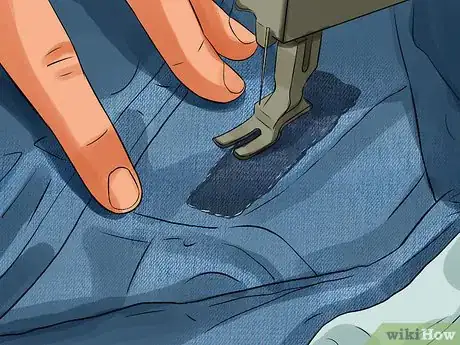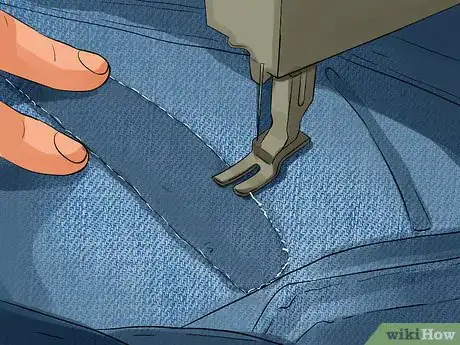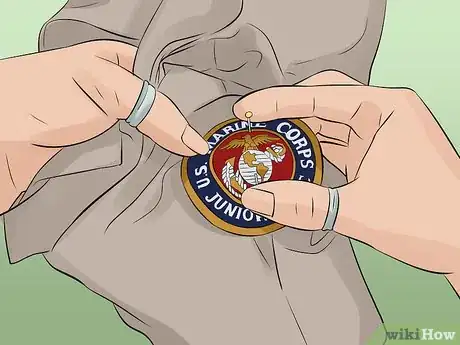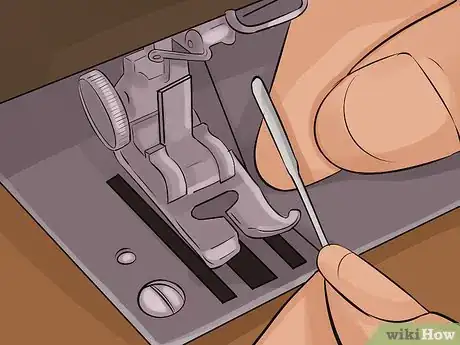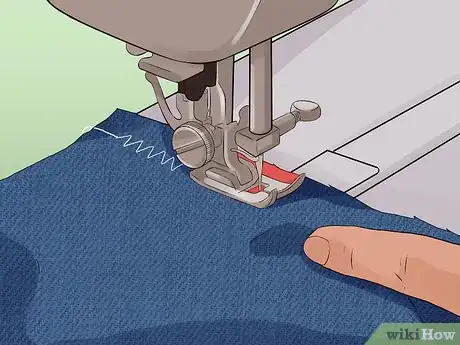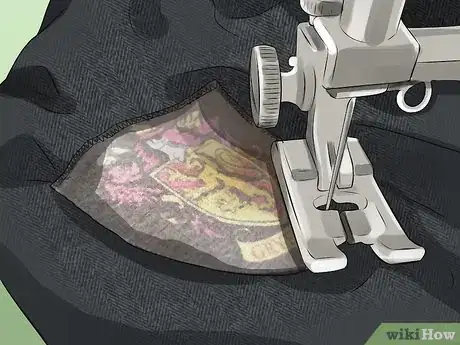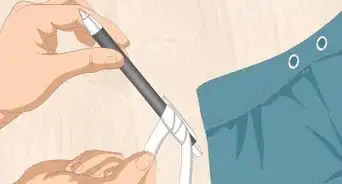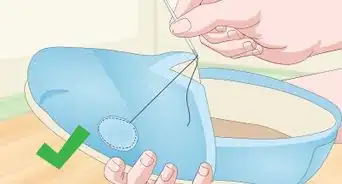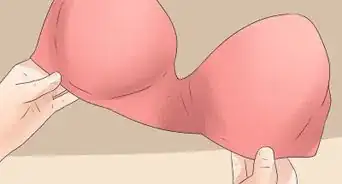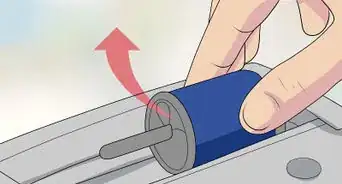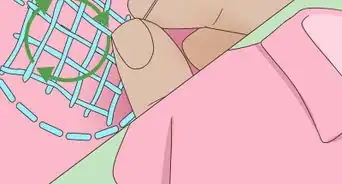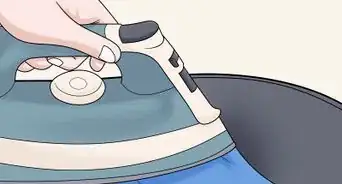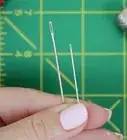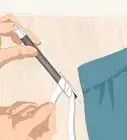This article was co-authored by Mia Danilowicz. Mia Danilowicz is a Master Tailor who works onset and on the red carpet in Los Angeles, California. With over a decade of experience, Mia specializes in bridal and gown couturier fittings, garment reconstruction, and custom design. Mia has worked at the Oscars, Grammys, SAG Awards, and Golden Globes. Her clients include a long list of entertainment and fashion industry headliners, major fashion magazines, luxury consumer brands, and popular media. Mia was trained at the Fashion Institute of Design and Merchandising and received her AA in Fashion Design and BS in Business Management.
This article has been viewed 58,152 times.
You can sew patches to cover up a hole, or as an embellishment on a fabric item. There are several things you can do to ensure that your patches serve their purpose and look good, such as sizing the patch material, securing the patch in place before sewing, and using the right type of stitch to secure your patch in place. Try sewing on your own patches the next time you need to cover up a hole or embellish something.
Steps
Sewing a Patch to Cover a Hole
-
1Get a patch that matches the fabric. It is important to make sure that your patch matches the fabric in your item. Otherwise, it will stand out from the rest of the material. Look for a patch that matches the fabric of your item as closely as possible.
- If you do not want to buy a patch, then you can also use a scrap of fabric.[1] Visit a local craft store to find fabric that matches your item, or visit a thrift shop and find something that you can cut up. You can even cut a scrap of fabric off of an old item that you no longer need or want.
- If you'll be applying the patch to the inside of the garment (to make it more inconspicuous), do not choose an adhesive patch. If you do, the sticky adhesive will be face-up under the hole.[2]
-
2Snip away any frayed edges. Frayed edges will get in the way when you are trying to sew the patch in place. They will also cause the patch to stand out more. Use a pair of scissors to snip away any frayed edges on your item. Try to make the edges of the hole as even as possible.[3]Advertisement
-
3Cut the patch as needed. You may need to cut your patch material down a bit depending on the size of the hole. Cut the patch so that it is large enough to cover the hole and any weakened areas of the item.[4]
- The patch should extend beyond the borders of the hole on all sides by about 1” (2.5 cm).
- Cut the patch so that it is the same shape as the hole as well. For example, if the hole is rectangular, then cut the patch into a similar rectangle.
-
4
-
5Pin the patch in place. Next, identify where the patch needs to go and lay it over the hole. Make sure that all of the edges are completely covering the hole and that the front side of the patch is facing down. Insert pins through the patch and item fabric along each of the edges to secure the patch in place.
- If your patch has fusing on the back of it, then you may want to iron the patch to secure it in place until you sew it. Apply even pressure to the edges of the patch to secure the patch to the fabric. Do not use steam.
- You can also use some adhesive, such as fabric glue, or double-sided tape to hold the patch in place until you are ready to sew.
-
6Thread your sewing machine or needle. You can either use a sewing machine or hand sew your patch in place. Thread your sewing machine or needle with a thread that matches or will blend in with your fabric.[7]
- If you cannot find an exact match for your fabric, then try using invisible thread.
- Depending on the thickness of your patch and item, you may want to use a heavy duty needle in your sewing machine or for hand sewing.[8] For example, if you are sewing a denim patch onto a pair of jeans by hand or with a sewing machine, then a heavy duty needle will work best. You may also need to adjust the stitch length.
-
7Sew around the edges of the patch to secure it. Use a straight stitch on your sewing machine or sew a straight stitch by hand using a needle and thread. Sew about ½” (1.3 cm) from the raw edge of the patch to ensure that it is going through the fabric of your item. Sew around the edges of the patch three times to ensure that it is secure.[9]
- You can also use a zig-zag stitch, if you prefer.[10]
- Remove the pins as you sew. Sewing over a pin may damage the needle and possibly even damage the machine.
- Trim the excess threads when you are finished.
Sewing a Decorative Patch onto an Item
-
1Determine where you want to place the patch. When you are sewing a patch onto the outside of an item, it is very important to consider the placement. You may need to have the patch in a specific place, such as for a scout badge on a sash or a patch on a nurse’s lab coat. Or, if you are using a patch to embellish an item, then the placement of your patch may affect the look of your item. Identify where you want or need the patch to go before you sew.[11]
- Make sure the item is right side out.
-
2Pin the patch onto the item. When you feel confident about the placement of your patch, pin it in place to mark the position. Use 2 or more straight pins to secure the patch to the fabric. Insert the pins near the center of the patch so they will not get in the way when you sew.[12]
- If desired, you can also use a small amount of washable glue, such as Elmer’s school glue, to help keep the patch in place while you sew.[13]
-
3Install a new heavy duty needle in your sewing machine. Patches that go on the outside of items are typically thick, so using a heavy duty needle will make sewing the patch in place much easier. Install a heavy duty needle in your sewing machine, such as a 90/14 universal needle.[14]
- If you are sewing by hand, then you should also use a heavy duty needle.
-
4Set your machine to a narrow zigzag stitch setting. A narrow zigzag setting works best for sewing patches onto items. This will ensure that the stitches go over the edges of the patch and through the patch as well. Set your machine to the zigzag stitch setting, and then reduce the stitch length and width to the narrowest possible size for your machine.[15]
-
5Sew around the edges of your patch. Raise your presser foot and needle and then line up the edge of your patch with the needle. Lower the presser foot and begin sewing around the edges of the patch. Go slowly to ensure that you only stitch along the edges of the patch. The zigzag stitch should overlap the edges of the patch and go into the fabric of your item right next to the patch.[16]
- You may also sew the patch in place by hand using a whipstitch if desired. However, this will take longer and the patch may not be attached as securely to your item. Using a sewing machine will be much quicker and the results will probably look better.
Expert Q&A
Did you know you can get expert answers for this article?
Unlock expert answers by supporting wikiHow
-
QuestionIs it better to put a patch over or under a hole?
 Mia DanilowiczMia Danilowicz is a Master Tailor who works onset and on the red carpet in Los Angeles, California. With over a decade of experience, Mia specializes in bridal and gown couturier fittings, garment reconstruction, and custom design. Mia has worked at the Oscars, Grammys, SAG Awards, and Golden Globes. Her clients include a long list of entertainment and fashion industry headliners, major fashion magazines, luxury consumer brands, and popular media. Mia was trained at the Fashion Institute of Design and Merchandising and received her AA in Fashion Design and BS in Business Management.
Mia DanilowiczMia Danilowicz is a Master Tailor who works onset and on the red carpet in Los Angeles, California. With over a decade of experience, Mia specializes in bridal and gown couturier fittings, garment reconstruction, and custom design. Mia has worked at the Oscars, Grammys, SAG Awards, and Golden Globes. Her clients include a long list of entertainment and fashion industry headliners, major fashion magazines, luxury consumer brands, and popular media. Mia was trained at the Fashion Institute of Design and Merchandising and received her AA in Fashion Design and BS in Business Management.
Master Tailor
-
QuestionWhat stitch is best for patches?
 Mia DanilowiczMia Danilowicz is a Master Tailor who works onset and on the red carpet in Los Angeles, California. With over a decade of experience, Mia specializes in bridal and gown couturier fittings, garment reconstruction, and custom design. Mia has worked at the Oscars, Grammys, SAG Awards, and Golden Globes. Her clients include a long list of entertainment and fashion industry headliners, major fashion magazines, luxury consumer brands, and popular media. Mia was trained at the Fashion Institute of Design and Merchandising and received her AA in Fashion Design and BS in Business Management.
Mia DanilowiczMia Danilowicz is a Master Tailor who works onset and on the red carpet in Los Angeles, California. With over a decade of experience, Mia specializes in bridal and gown couturier fittings, garment reconstruction, and custom design. Mia has worked at the Oscars, Grammys, SAG Awards, and Golden Globes. Her clients include a long list of entertainment and fashion industry headliners, major fashion magazines, luxury consumer brands, and popular media. Mia was trained at the Fashion Institute of Design and Merchandising and received her AA in Fashion Design and BS in Business Management.
Master Tailor
-
QuestionI wanted to sew a patch on the front of a t shirt. How would I do it?
 Community AnswerT-shirts are highly customizable. You can have the ends of the patch show outward without being rolled inside by sticking with fabric glue or sewing it, you can roll or overlock the patch in a color of thread you like and have it stitched. Place the shirt properly spread out, place the patch where you want it, pin it in place to keep it attached, then sew it in small stitches. Don't pull the thread too tightly; instead, leave some gaps in between so that after washing, it allows for stretching.
Community AnswerT-shirts are highly customizable. You can have the ends of the patch show outward without being rolled inside by sticking with fabric glue or sewing it, you can roll or overlock the patch in a color of thread you like and have it stitched. Place the shirt properly spread out, place the patch where you want it, pin it in place to keep it attached, then sew it in small stitches. Don't pull the thread too tightly; instead, leave some gaps in between so that after washing, it allows for stretching.
Things You’ll Need
- Patch or patch material
- Pins
- Scissors
- Adhesive, double sided tape, or an iron (optional)
- Sewing machine or needle and thread
- Heavy duty needle for your sewing machine or for hand sewing
References
- ↑ Mia Danilowicz. Master Tailor. Expert Interview. 8 January 2021.
- ↑ Mia Danilowicz. Master Tailor. Expert Interview. 8 January 2021.
- ↑ http://www.manmadediy.com/users/dan_e_t/posts/2651-the-diy-tailor-an-easy-way-to-fix-holes-in-your-jeans-and-other-garments
- ↑ https://www.gq.com/story/the-best-way-to-fix-your-ripped-jeans
- ↑ http://www.manmadediy.com/users/dan_e_t/posts/2651-the-diy-tailor-an-easy-way-to-fix-holes-in-your-jeans-and-other-garments
- ↑ Mia Danilowicz. Master Tailor. Expert Interview. 8 January 2021.
- ↑ Mia Danilowicz. Master Tailor. Expert Interview. 8 January 2021.
- ↑ https://thesewingloftblog.com/sewing-uniform-patches/
- ↑ https://www.gq.com/story/the-best-way-to-fix-your-ripped-jeans
- ↑ Mia Danilowicz. Master Tailor. Expert Interview. 8 January 2021.
- ↑ https://www.youtube.com/watch?v=fImrfdsvL3A
- ↑ https://www.youtube.com/watch?v=fImrfdsvL3A
- ↑ https://thesewingloftblog.com/sewing-uniform-patches/
- ↑ https://thesewingloftblog.com/sewing-uniform-patches/
- ↑ https://thesewingloftblog.com/sewing-uniform-patches/
- ↑ https://www.youtube.com/watch?v=fImrfdsvL3A
